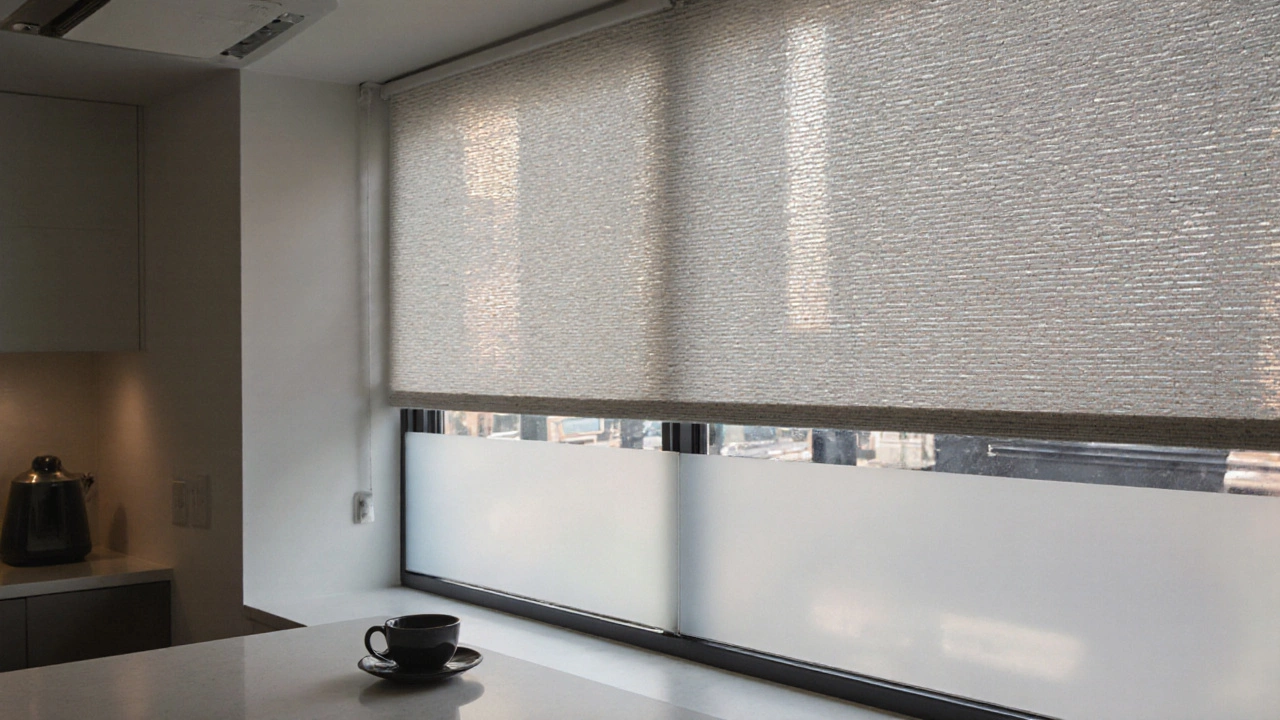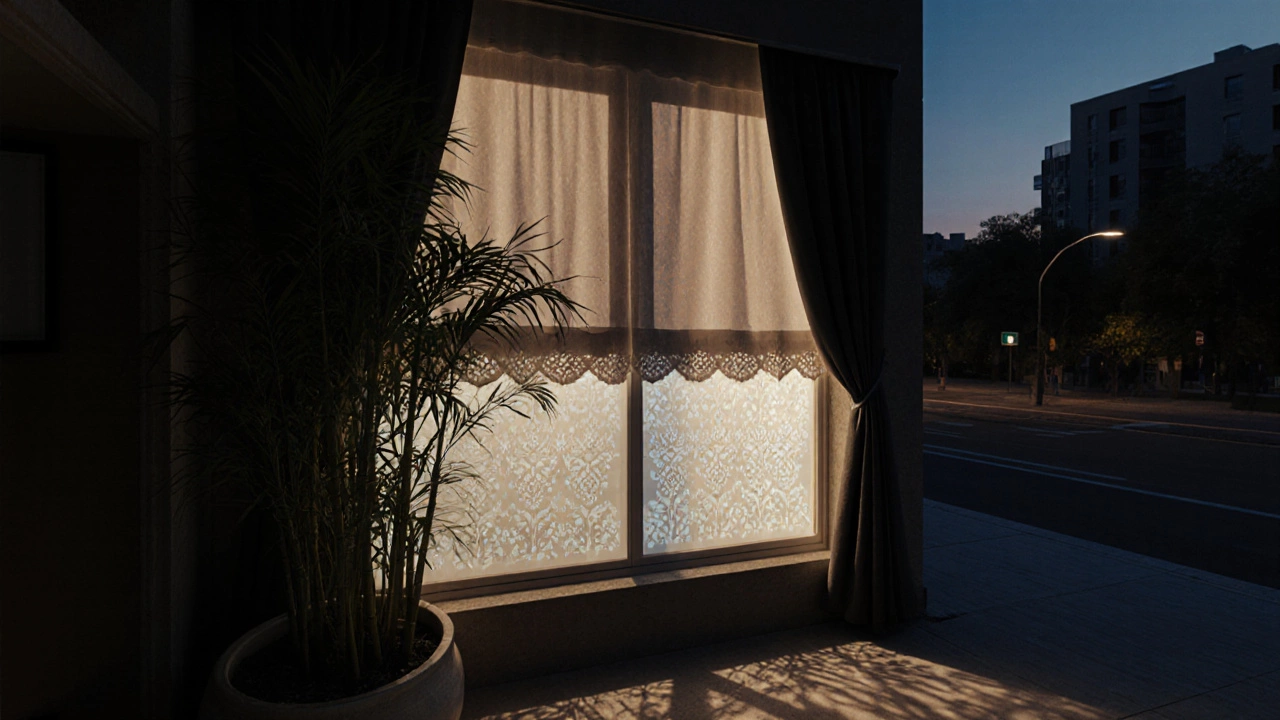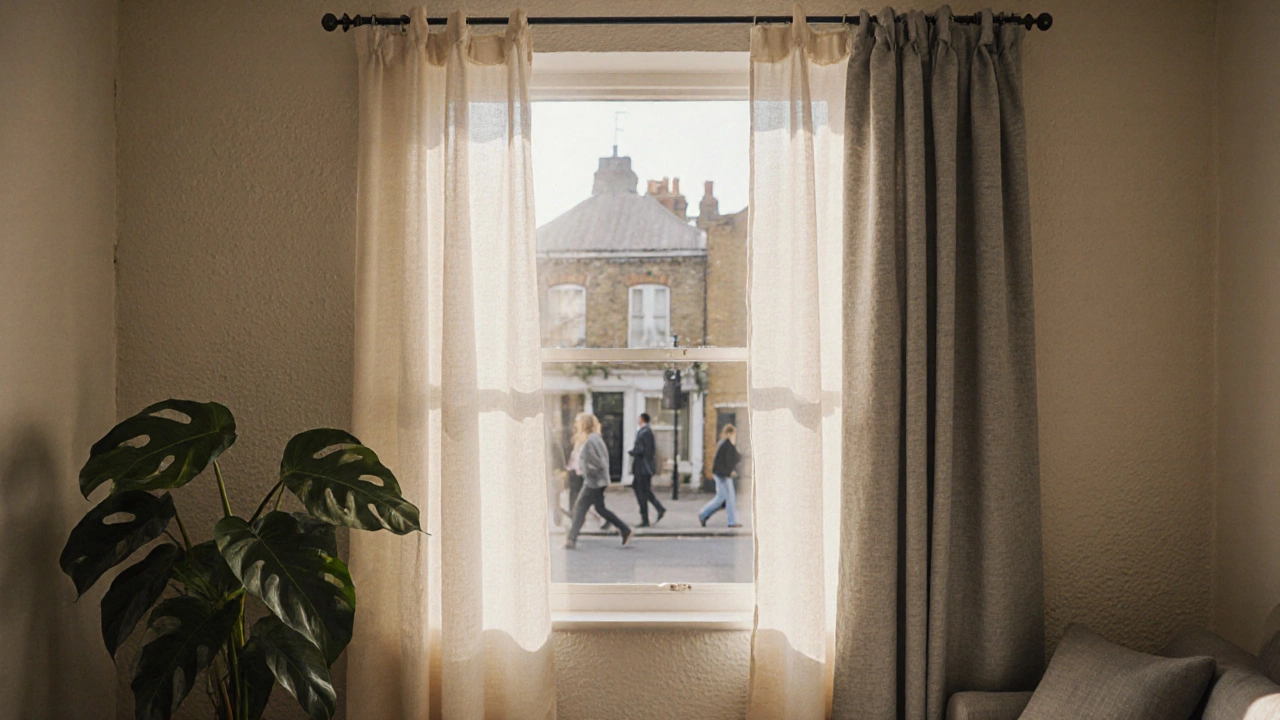Window Privacy & Light Calculator
Recommended Solutions
Ever sat in your living room at night and felt like everyone on the street can see right in? Or maybe you work from home and need privacy without turning your room into a cave? You don’t need to choose between darkness and daylight. There’s a simple, effective way to keep your windows private while still letting natural light flow in - and it doesn’t require replacing your curtains or drilling holes in the wall.
Start with the right fabric
Not all curtains are made equal when it comes to privacy and light. Heavy blackout curtains block everything - good for sleep, terrible for daytime comfort. On the other end, thin cotton sheers give you light but almost zero privacy, especially when the sun’s behind them. The sweet spot? Light-filtering curtains made from tightly woven, semi-sheer fabrics like linen blends, polyester voile, or woven bamboo.These materials diffuse sunlight instead of letting it pass straight through. From the outside, your room looks softly glowing - not clear enough to make out shapes, furniture, or people. From inside, you get bright, even daylight without glare. Try a cream or oat-colored option; darker tones can make rooms feel smaller and absorb too much light.
Layer your curtains
One curtain isn’t enough if you want full control. The most effective setup in homes across Oxford and beyond is a two-layer system: a sheer curtain on the inner track and a heavier, light-blocking drape on the outer track.Here’s how it works:
- During the day: Pull back the heavy drape and leave the sheer curtain open. Light pours in, but passersby only see a soft, blurred outline of your space.
- At night or when you need more privacy: Close the sheer curtain and pull the heavier drape shut. You’ve got total privacy without sacrificing the look of layered window treatments.
This setup costs less than a new window and gives you more flexibility than blinds. Plus, it looks intentional - not like you’re hiding. Many interior designers in the UK use this method in townhouses and apartments where street visibility is a real issue.
Use window film for instant privacy
If you’re renting or don’t want to install new hardware, window film is your best friend. Modern frosted or decorative window films are easy to apply, removable, and come in patterns that mimic etched glass, frosted lace, or even abstract textures.Look for films labeled as "daytime privacy" - these are designed to be opaque from the outside but still let in 70% or more of natural light. Brands like 3M and Gila make films that don’t yellow over time and won’t damage your glass. Apply them yourself with a spray bottle of soapy water and a squeegee. It takes under an hour per window.
Pro tip: Avoid full-window coverage if you have a view you love. Instead, apply the film only to the lower half - the part most visible from the street. Keep the top clear to preserve the sense of openness and let in top-down light.

Try roller shades with privacy weaves
Roller shades have come a long way. Today’s options include "privacy weaves" - woven fabrics with tiny gaps that let light through while hiding what’s inside. These are perfect for kitchens, bathrooms, and home offices where you need bright light but don’t want people staring in.Look for shades made from polyester or PVC-coated polyester with a "one-way vision" weave. From the inside, you see clearly out. From the outside, it looks like a solid, frosted panel. Some even come with motorized options that sync with your smart home system. They’re low-profile, don’t collect dust like curtains, and roll up neatly when not in use.
Use plants as natural privacy screens
If you have a balcony, windowsill, or even just a floor space near your window, indoor plants can help. Tall, leafy plants like fiddle-leaf figs, snake plants, or bamboo palms act as living privacy screens. They don’t block light - they soften it.Place them in front of your window, especially if it’s at eye level from the street. The leaves scatter the view without making your room feel closed in. Add a small shelf or hanging planter to maximize space. In the UK, this is a popular trick in city flats where windows face alleyways or neighboring buildings.
Don’t forget the hardware
The right curtain rod and mounting position can make or break your privacy setup. Mount your curtain rod as close to the ceiling as possible and extend it 6-12 inches beyond each side of the window frame. This ensures the curtains fully cover the window when closed, eliminating gaps where light leaks out - and eyes peek in.Use double rods if you’re layering sheers and drapes. Single rods with multiple rings often cause bunching and uneven coverage. If you’re on a budget, tension rods work fine for sheer curtains. Just make sure they’re sturdy enough to hold the weight without sagging.

What to avoid
Some common fixes make privacy worse:- White blinds - they reflect light and make your room visible from outside, especially at dusk.
- Single-layer lace curtains - they’re pretty but offer almost no privacy when lit from within.
- Placing furniture too close to the window - sofas and chairs near the glass create silhouettes that are easier to see from outside than you think.
- Using dark, heavy curtains during the day - you’ll lose natural light and make your space feel smaller and gloomy.
Also, avoid tinted glass or spray-on privacy coatings unless you’re doing a full renovation. They’re permanent, can reduce energy efficiency, and often look cheap.
Real-life example: A flat in Oxford
A resident on St. Giles Street had a ground-floor window facing a busy sidewalk. She tried blackout curtains - too dark. She tried blinds - too noisy and unattractive. Then she installed a double-layer system: a white linen sheer on the inner track and a light gray thermal drape on the outer track. She added a frosted film to the bottom third of the glass. Result? Her room stays bright all day, no one can see in, and her neighbors compliment the "elegant look." She didn’t spend more than £150.Quick checklist for privacy + light
- Choose semi-sheer, tightly woven fabrics for daytime privacy
- Install double curtain rods to layer sheers and drapes
- Apply daytime privacy window film to lower window sections
- Use roller shades with privacy weave for modern, low-maintenance options
- Place tall indoor plants in front of windows for natural screening
- Mount curtains high and wide to eliminate gaps
- Avoid white blinds, single lace curtains, and dark fabrics during the day
Privacy doesn’t mean closing off your home. It means controlling what people see - without losing the connection to the outside world. With the right materials and setup, you can have both: sunlight streaming in and peace of mind that your space is yours alone.
Can I use sheer curtains for privacy at night?
No. Sheer curtains let light pass through both ways. At night, when your lights are on, people outside can see silhouettes and shapes clearly. For nighttime privacy, you need a layer that blocks light - like a blackout drape, privacy film, or woven roller shade.
Are blackout curtains the only option for total privacy?
No. Blackout curtains block all light, which isn’t always desirable. You can get total privacy without darkness by using privacy window film, woven roller shades, or layered curtains with a sheer inner layer and a dark outer layer. This way, you control light and privacy separately.
Will privacy film damage my windows?
No, if you use removable, non-permanent films designed for residential use. Brands like 3M and Gila make films that adhere with a water-activated adhesive and peel off cleanly without leaving residue. Avoid cheap, adhesive-backed films - they can trap moisture and cause glass to crack in extreme temperatures.
What’s the cheapest way to add privacy to windows?
The cheapest option is DIY window film - you can buy a roll for under £20 and apply it yourself. Second cheapest is using existing sheer curtains with a second layer of lightweight drapes you already own. Avoid buying new hardware unless necessary.
Can I use curtains in a bathroom for privacy?
Yes, but choose moisture-resistant fabrics like polyester blends or vinyl-coated materials. Avoid cotton or linen - they’ll mildew. Pair a privacy film on the glass with a lightweight, quick-drying curtain for the best results. Roller shades with privacy weave are also ideal for bathrooms.
Do smart curtains help with privacy and light control?
Smart curtains can automate your setup, but they don’t change the fabric’s properties. You still need the right material - sheers for light, blackout for privacy. Smart systems are useful if you want to open and close curtains automatically at sunrise or sunset, but they’re not a substitute for proper fabric choice.
